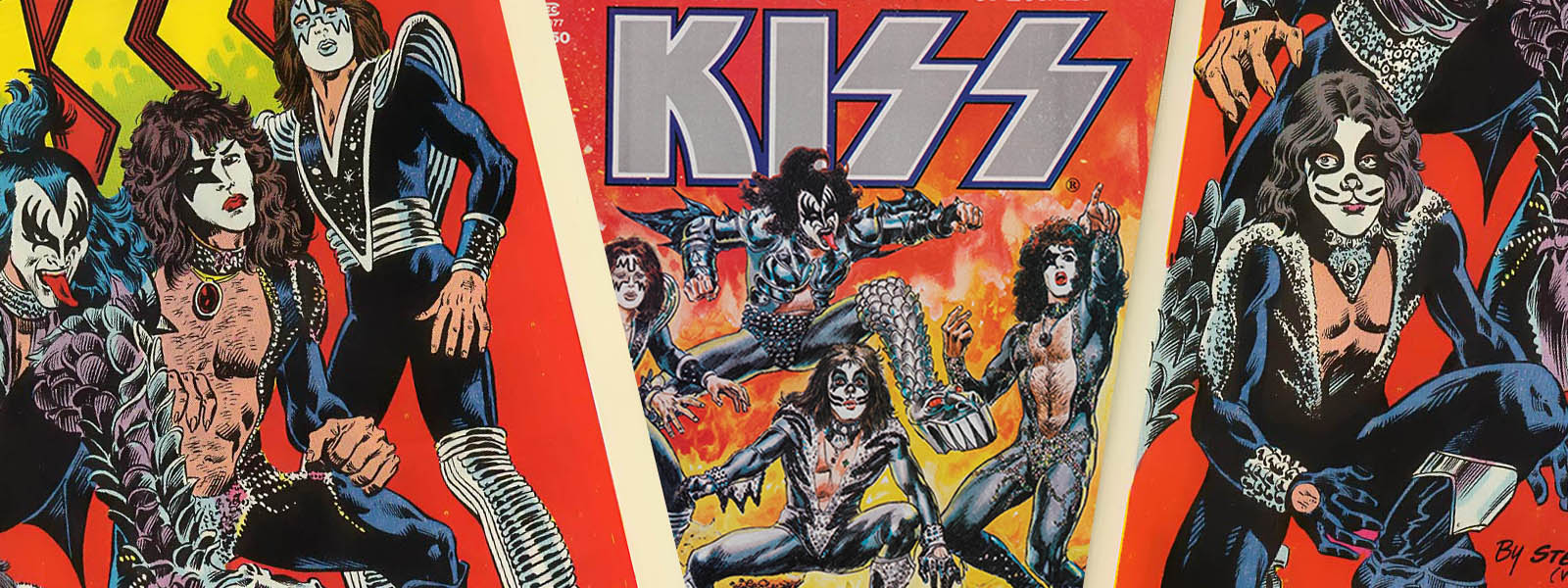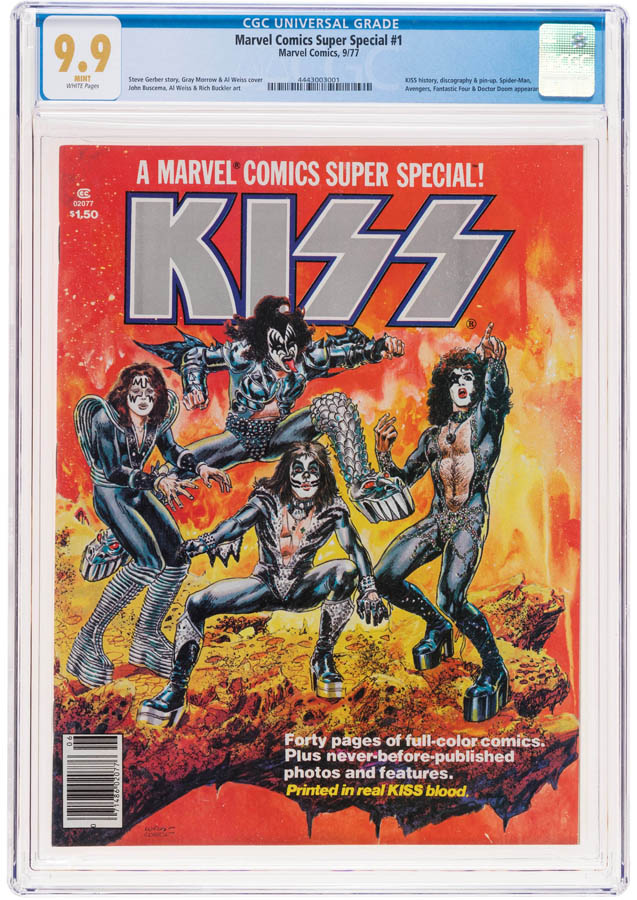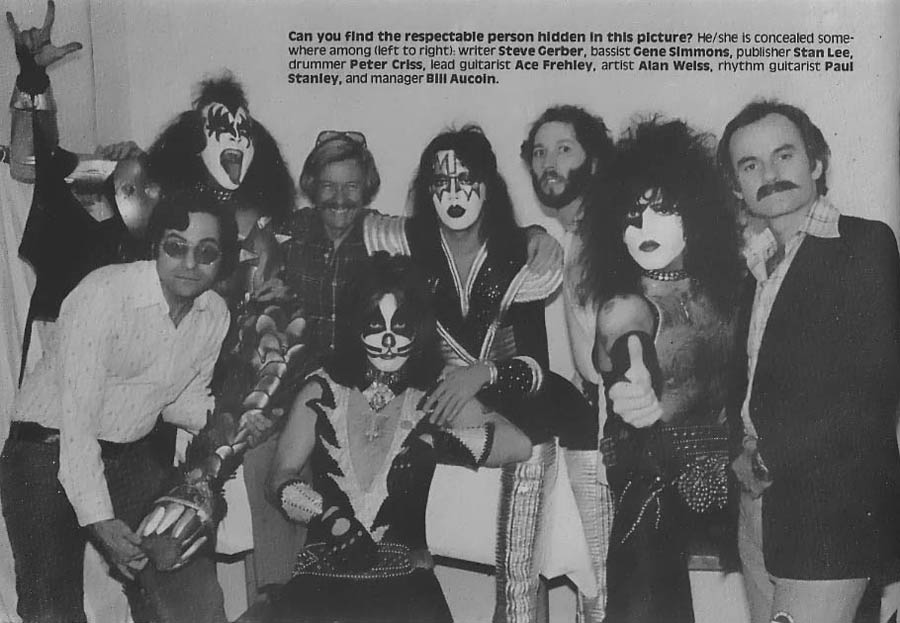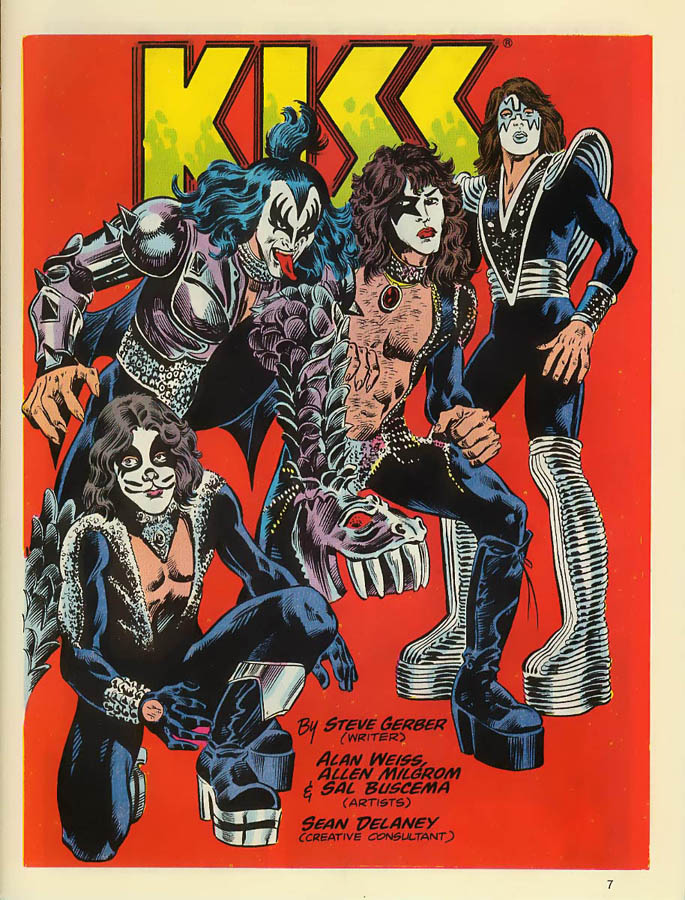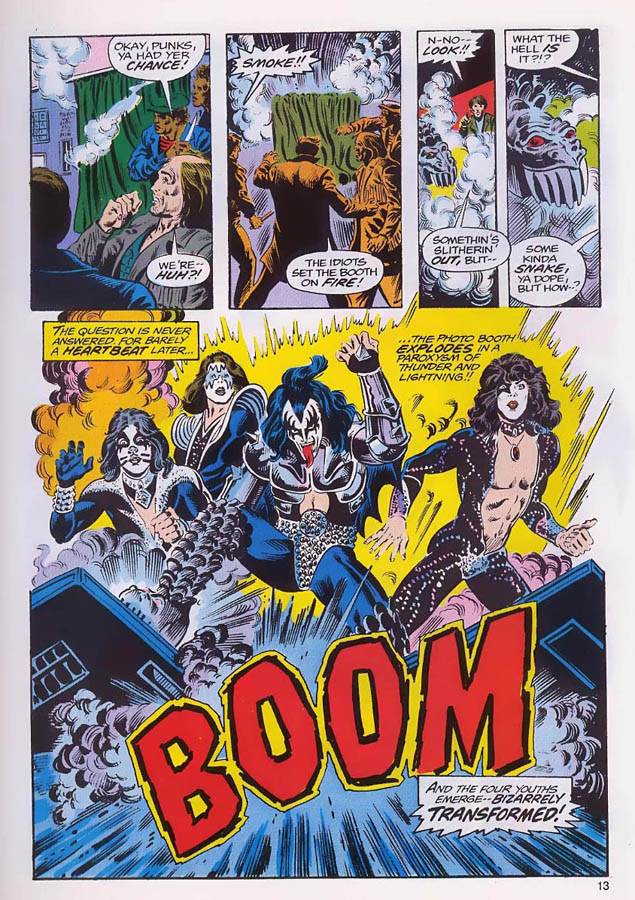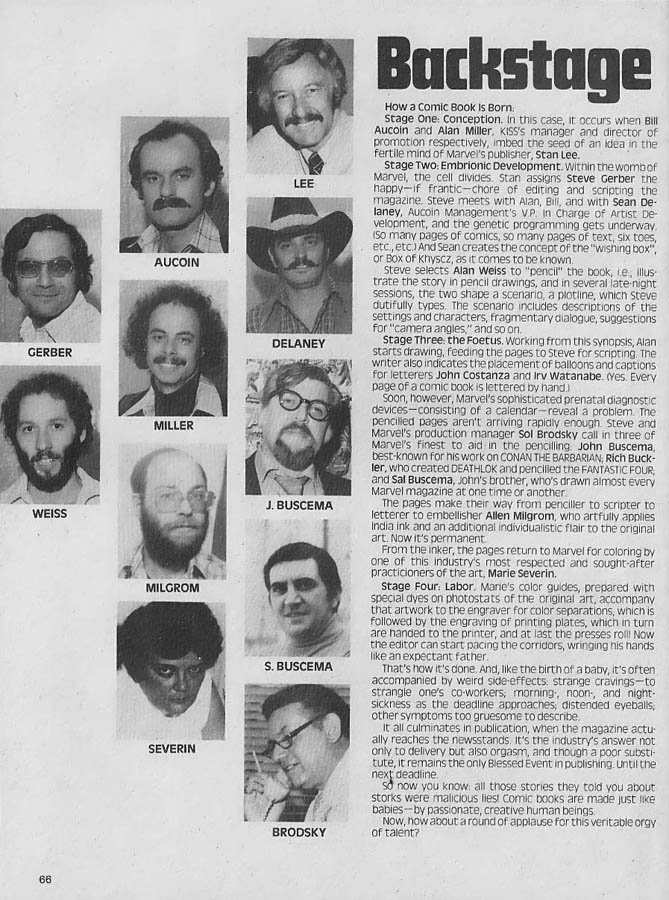IN THE SUMMER OF 1977, MARVEL WENT METAL FOR ONE OUTRAGEOUS ISSUE. HERE, THE ARTIST BEHIND THE COMIC BOOK RECOUNTS HOW IT ALL CAME TOGETHER.
By Robert Wilonsky
Everything about the first issue of Marvel Comics Super Special was big – its magazine size, its $1.50 cover price, its all-star cast (Spider-Man, the Avengers, the Fantastic Four and more), its print run of nearly 1 million copies. Legend has it that Marvel Comics Super Special No. 1, which debuted June 21, 1977, was the company’s top-selling comic until Todd McFarlane suited up for the million-plus-selling Spider-Man No. 1 in 1990. Which sounds about right – like “Rock and Roll All Nite” or “Shout It Out Loud” or “Deuce” cranked all the way up with the car windows rolled all the way down.
Just look at that glorious cover! The logo: KISS! The band, drawn by Alan Weiss and painted by Gray Morrow! The promise of 40 pages of “full-color comics”! And all 40 pages “printed in real KISS blood,” no less (but not really).
The highest-graded copy of 1977’s ‘Marvel Comics Super Special’ No. 1 starring the rock band KISS is available in Heritage’s September 12-15 Comics & Comic Art Signature® Auction.
We, the proud enlistees in the KISS Army, stormed the newsstands in June 1977, when everything Gene Simmons, Paul Stanley, Ace Frehley and Peter Criss kissed turned to gold. Especially a comic book that pit The Demon, The Starchild, The Spaceman and The Catman against the Fantastic Four’s nemesis Doctor Doom, which made no sense and all the sense in the world.
“We were all about taking the most incredible, ridiculous and inappropriate stuff and making it work,” says Weiss, who drew most of the book and co-plotted it with Steve Gerber, best known as Howard the Duck’s creator. Gerber and Weiss weren’t KISS fans when they started working on Marvel Comics Super Special No. 1. By the time it came out, they were converts – fans and friends.
“Steve could keep the innocence and bring enough intelligence to the backstory,” Weiss says. “We were always aware that you’re reading a story and playing along. Instead of saying, ‘Well, this doesn’t seem right,’ you’re like, ‘Are you kidding me? What are you gonna do now?’ Yeah, KISS is ridiculous, but that was part of the mythology: They were already comic book characters.”
In September, Heritage will auction the world’s single finest copy of Marvel Comics Super Special No. 1 – a unicorn graded 9.9 by Certified Guaranty Company, which means it’s mint and likely to sell well into the five figures. That tracks: Even beat-up copies sell for a few hundred dollars – when you can find them. One of the most storied comics of the 1970s has become one of the hardest to own in 2024. Weiss isn’t even sure if he has any copies. He sure doesn’t have the original art: KISS’ late manager, Bill Aucoin, bought it from him years ago – most likely for Gene Simmons, a comic book fan (and teenage fanzine publisher!) long before he became a comic book character.
Gene Simmons, Peter Criss, Ace Frehley and Paul Stanley with the crew responsible for ‘Marvel Comics Super Special’ No. 1, including artist Alan Weiss
The backstory behind the comic’s publication would make a fine made-for-TV movie – better, anyway, than KISS Meets the Phantom of the Park, which aired a year later on NBC and was never again to be mentioned in the band’s presence.
In his introduction to Marvel Comics Super Special No. 1, Gerber wrote that, yeah, sure, he’d been a rock fan – and college radio disc jockey – and that he’d “well, sorta heard of ’em, kinda.” But that just meant he was familiar with the band’s logo, which was designed by guitarist Ace Frehley and had become inescapable by the mid- to late 1970s. He’d never heard “so much as a note of their music,” he wrote, or “even seen their costumes or painted faces.”
But Gerber, a comms major in college, and publisher Stan Lee were savvy enough to know that Marvel also needed to elbow its way onto the newsstands next to Rolling Stone, Creem and Circus, the rock mags too big for spinner racks. By the mid-1970s, Marvel was the hipster to DC’s square, heavy metal compared to the Super Friends’ bubblegum pop.
A full-page illustration of the band graces Page 7 of the sought-after comic book.
Comic book writer Mary Skrenes, who co-created Omega the Unknown with Gerber, has said the timing was perfect. In Comic Book Fever, she wrote that KISS, likely at Simmons’ prodding, approached Marvel about turning the band into superheroes. Lee was into it; Marvel management, less so. But within short order, Gerber met with Aucoin – a former TV cameraman who scored the band a record deal and helped define its fire-breathing, blood-spitting, platform-boot-wearing image – to nail down the book.
Skrenes suggested her old pal Weiss to Gerber, convinced they’d be a perfect pair. If nothing else, she wrote, “I thought [Weiss] could capture these rock ‘n’ roll freaks dancing in platform boots. Plus, he would approach it with an open mind.”
Weiss, like Gerber, wasn’t all that familiar with KISS. He says he was more into soul and R&B (“James Brown, Otis Redding, the Motown stuff”); he liked his rock prog and progressive, too (Yes, the Moody Blues, Traffic and Emerson, Lake & Palmer). But Weiss and Gerber began spending time with the band, attending numerous shows – at Madison Square Garden, in Toronto and elsewhere – and hanging out with Simmons at his apartment. Weiss, one of the Bronze Age greats who’d worked on numerous titles for Warren, Marvel and DC, says Simmons recognized him immediately when they first met backstage at Madison Square Garden, where KISS management had gathered to stage “the blood ceremony” documented in the behind-the-scenes photos collected in the comic.
“It was a photo op,” Weiss says. “They got this actor in a white coat to pretend he was drawing their blood, so we’re down in the basement – Steve, Stan Lee, this ‘doctor’ and me – and we’re waiting for KISS to show up. The elevator door opens, and the first one I see is Gene in the whole outfit, including the monster boots. He looks 7 feet tall between the boots and the hair and starts walking right toward me. I stand up and hold out my hand, and he says, ‘Alan Weiss, I’m a huge fan of yours.’ Can you imagine? This huge monster’s moving toward me, and he started talking about how he’s a huge fan of my comics. That’s how the whole deal came together.
“And I experienced it all while sitting next to Stan Lee, who does not really love the music – or understand it at all. Once, a cherry bomb goes off under his seat. He didn’t want to look too perturbed, but he was freaked out. He said, ‘What’s that!?’ And I said, ‘That’s rock and roll, Stan!’”
Page 13 of ‘Marvel Comics Super Special’ No. 1 depicts the moment four regular teenagers transform into KISS.
But Lee didn’t control Marvel, and management kept stalling the project. Skrenes wrote that was because Marvel “did not want to put out a book with characters they didn’t own.” And, more to the point, “they really had no idea who or what KISS was.” Gerber and Weiss kept working on the story while Gerber was pushing Aucoin to threaten Marvel with a lawsuit if they didn’t follow through on the promised book.
In the end, Marvel relented – then panicked to get the book on newsstands by June 1977, the week before the band released Love Gun. The wait-and-hurry-up approach forced Gerber and Weiss to bring in other Marvel artists to help finish the book, including John Buscema, Rich Buckler and Al Milgrom – some of the company’s best-known names.
Weiss might not have known much about KISS when he signed on to the project, but he quickly became a convert: He thought Frehley was “a hell of a guitar player,” appreciated how much Criss sounded like a jazz drummer and found the songs “catchy as hell.” When he sat down to draw the book, about four regular teens transformed into KISS thanks to the mysterious “Box of Khyscz” (pronounced KISS, natch), Weiss listened to nothing but KISS records.
“I imagined myself being a kid at a KISS concert, and the bottom line is, you let the energy tell you how to feel,” he says. “This book was going to express that. The band was trying to express Gene Simmons’ inspirations from the comics, and we were trying to return the favor. You get out of your own editorial head, and you let the feeling go. Then you’re talking art.”
A closer look at the team behind the KISS comic book
This was never something the squares were going to get: When the band, Gerber, Weiss and Lee flew to the printing plant near Buffalo to dump the vials of blood into a vat of red ink, WGRZ-TV reported on how it was “the last word in promotional stunts.” Reporter Mike Hegedus lampooned the arrival of the “strangely attired and hairy fellows” who brought their blood to the printing plant.
“Isn’t that wonderful?” he sneered about the stunt that “may or may not have been in bad taste, depending on yours.” He signed off by lamenting, “It would be nice to think people won’t be sucked in by this type of thing.”
Ah. But we were.
Two days before the comic’s release, The New York Times ran a massive story detailing the making of “An Outrage Called KISS,” illustrated with Weiss’ two-page spread from the comic featuring KISS in space – a majestic work that looked like something Jack Kirby and Neal Adams might have made after rocking and/or rolling all night. And a week after the comic’s publication, the band released what would become its best-selling studio album and its first Top 5 album, Love Gun.
Marvel never did understand what it had: Shortly before the comic’s publication, Gerber inserted KISS into two Howard the Duck comics, but when it came time for the inevitable sequel, none of the original creative team returned. Nobody at Marvel ever talked about the comic, and Weiss wasn’t even sure how well the book did, though its reprinting in 1995 suggested that, yeah, maybe they’d been onto something.
As far as Weiss was concerned, all that mattered was that KISS and the KISS Army dug it. Because he sure did.
“Did you like it when you were a kid?” Weiss asks.
“Absolutely,” he is told. “I was 8 years old. And I loved it.”
“Then we won.”
 ROBERT WILONSKY is a staff writer at Intelligent Collector.
ROBERT WILONSKY is a staff writer at Intelligent Collector.

